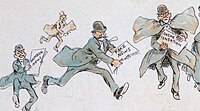
Photo from wikipedia
ABSTRACT This paper examines the effects of different genres of body art on the perceived trustworthiness of hypothetical men and women with tattoos. It argues that body art is a… Click to show full abstract
ABSTRACT This paper examines the effects of different genres of body art on the perceived trustworthiness of hypothetical men and women with tattoos. It argues that body art is a salient cultural signal that denotes group membership and can also lead to the perception of a potential threat of harm on the part of the truster. The research finds that tattoos depicting images of violence and nudity result in the lowest levels of perceived trustworthiness; tattoos depicting images of Christianity and natural floral settings result in the highest levels of perceived trustworthiness; and the tribal tattoo genre occupies a neutral position on the trustworthiness spectrum. Whether the truster has a tattoo and shares the Christian faith with the trustee are also significant factors, as is the gender of the tattooed trustee. This paper is the first study ever to examine the effects of different genres of tattoos, thus going beyond previous research that overwhelmingly measures body art as a simple binary variable (e.g. whether or not the respondent has a tattoo).
Journal Title: Journal of Trust Research
Year Published: 2017
Link to full text (if available)
Share on Social Media: Sign Up to like & get
recommendations!